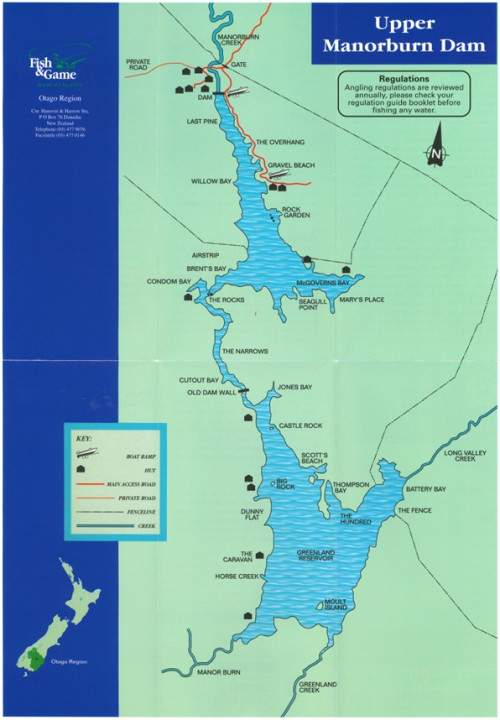History
Set in the hills at the south end of the Ida Valley is the Upper Manorburn Dam. This irrigation storage reservoir of 700 hectares has a shoreline of 14km, so there is room for a lot of anglers. It was completed in 1914 and is administered by the Ida Valley Irrigation Company. The first fish release was of brown trout into the coffer dam behind the main structure in 1913. Since then rainbow trout have been introduced and today it has evolved as an exclusively rainbow trout fishery. The last brown trout was caught in 1948 by Bill Leask and weighed 4kg. This water opens on 1 November each year and closes on 31 May.
Getting There
There is only one access road to this water, which is at the end of the Moa Creek Road that leaves the Ida Valley Road at the Poolburn Hotel. After leaving the tarseal you enter a gate that has the ‘Upper Manorburn’ sign on the left. This is a gravel road with several gates on it and takes you to the dam wall. Unfortunately the last section of road on the left leading up to the dam is not gravelled and is in very poor condition. The road to the right that takes you across the Manorburn Creek travels past most of the lake and this road is on private land. Permission is required to travel on this road. Please drive carefully from where you enter the first gate as stock will likely be on the road.
Access
There is a boat launching site at the dam wall on the left-hand side. A vehicle track leads to several huts further up this side and eventually to a gravel beach about a kilometre from the wall, which is often used to launch in southerly winds. This is about as far as you can take a vehicle up the side of the lake. Boating is the best method to reach the Greenland Reservoir end. If boating, caution is necessary at the start of the narrows as there are some submerged rocks on your left.
Please select image for larger view.
Methods
This reservoir has two sections. The lower basin is mainly deep water, with some shallow areas in McGoverns Bay. This continues through the narrows to the Greenland Reservoir, most of which is quite shallow. All legal methods can be used, with the most successful being the worm for the early part of the season.
Bait
When worm fishing fish close to the rocky areas, as rainbows don’t tend to inhabit the sharp shallow bays until summer. Most people use the traditional weighted method, but good success can be had in the summer fishing with a bubble and worm in shallower water.
Trolling
Trolling is good throughout the season and anglers should use copper Zed Spinners on a surface line (nylon) or blood-red Tillins on a leadline to start with. Anglers use about two colours of leadline out with about 10m of nylon trace in the lower basin, but it is too shallow in the Greenland Reservoir for leadlines. Use about 80m of nylon out on your surface line. Other lures that work well are Tasmanian Devils patterned in traffic light, fluorescent pink and red-nosed silver. Rapalas, Jensen Insects and Tobys with red are also popular.
Spinning
Spin anglers will do well with similar patterns to those described for trolling, but they should also try red and gold Veltics and black Tylos. Again concentrate on the deeper water off rocky points as rainbows prefer at least being close to deep water where they can dart to safety if startled.
Flyfishing
Flyfishing is also very popular, with feathered lures predominant early in the season. Successful patterns include Mrs Simpson, Red Setter, Kilwell No.1 or 2, and Woolly Buggers in green or black. Once the weed starts to grow, use damselfly nymphs and corixa. The best dry flies are Royal Wulff, Humpy and Black Gnat. In the height of summer as with other lakes in the area there is a considerable cicada hatch as well as prolific midge hatches at dawn and dusk.
